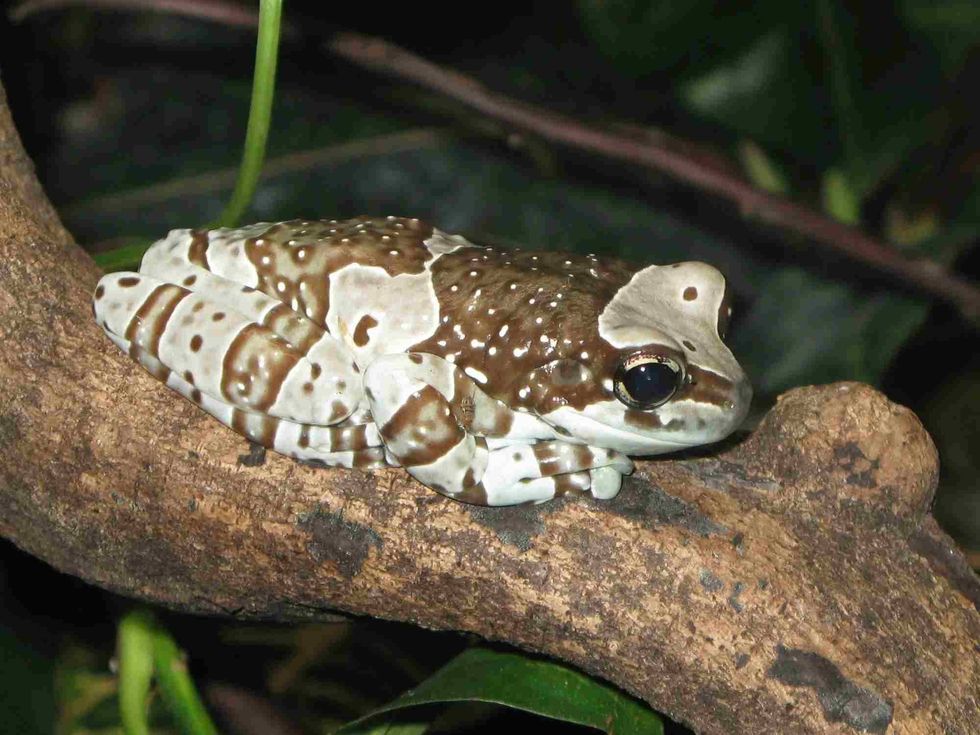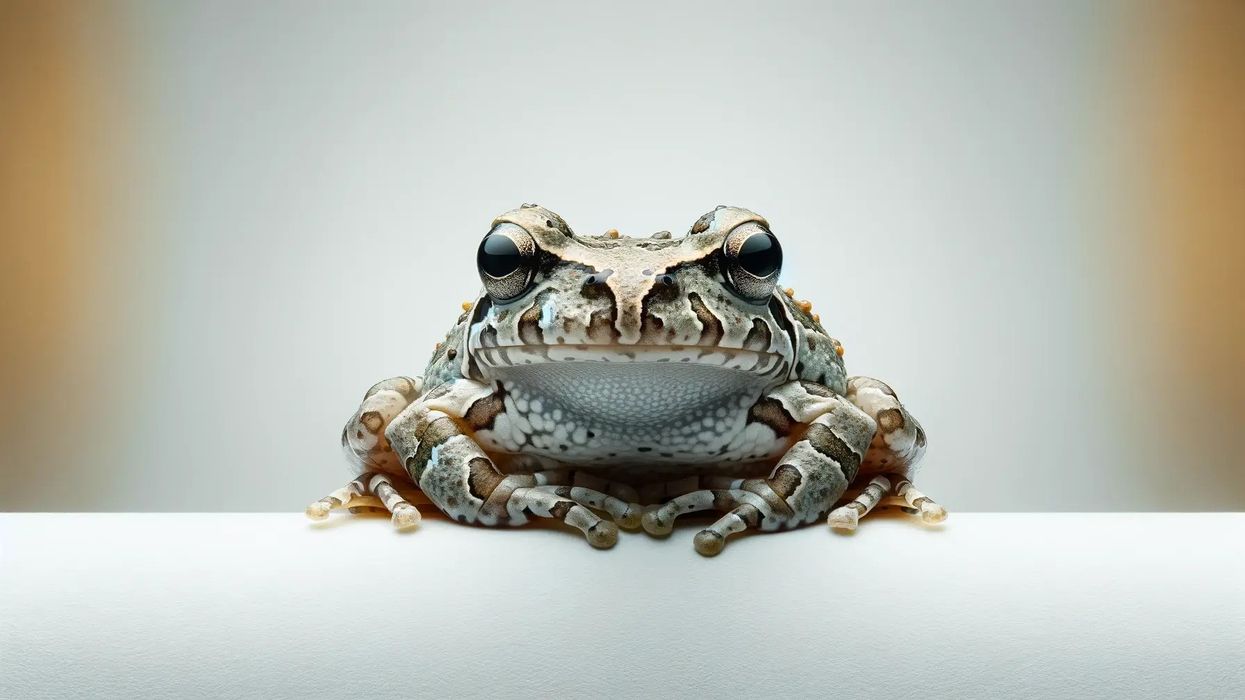The Amazon milk frog (Trachycephalus resinifictrix) is a species of arboreal frog found in the trees of the Amazon Rainforest in South America. This tree frog is also known as the mission golden-eyed tree frog or blue milk frog.
The name 'Amazon Milk' does not refer to the coloration of its body but refers to the milky, white, sticky secretion excreted by them when threatened. These are large frogs with well-developed toe pads that assist them in climbing various trees with great ease.
Amazon milk frogs (Trachycephalus resinifictrix) can be found in large numbers in the northern South American Rainforest canopy, near slow-moving water. They are nocturnal carnivores and feed on insects, spiders, and worms.
In recent years, this species has gained popularity in the pet trade world. These frogs make for great pets.
They should, however, be maintained and handled with great caution as their skin is highly sensitive and they can easily get hurt. Besides this, these nocturnal frogs are quite entertaining to look at.
Their population is stable and has been listed as Least Concern by the International Union for Conservation of Nature. However, factors like deforestation and clear-cutting of rainforest canopy have contributed to their habitat loss and a population decline.
The Amazon milk frog (Trachycephalus resinifictrix) is an interesting creature to learn about. Keep reading to find out more fascinating facts about this animal. If you enjoy reading about frogs, be sure to check out tree frogs and pickerel frogs.
Amazon Milk Frog Interesting Facts
What type of animal is an Amazon milk frog?
The Amazon milk frog is a type of frog.
What class of animal does an Amazon milk frog belong to?
The Amazon milk frog (Trachycephalus resinifictrix) belongs to the class Amphibia and the family Hylidae.
How many Amazon milk frogs are there in the world?
There are no studies to calculate the total population of Amazon milk tree frogs in the world.
Where does an Amazon milk frog live?
The Amazon milk frog (Trachycephalus resinifictrix) can be found in large numbers in northern South America. Their populations are widespread in South America in countries such as Colombia, Brazil, Guyana, Peru, and Ecuador. They can also be found in the rainforest canopy of Trinidad and Tobago, Venezuela, and various other islands near the South American coast.
What is an Amazon milk frog's habitat?
In the wild, milk frogs can be found living in the tropical rainforest canopy. They can rarely be found on the ground. During the breeding season, males can be found in water-filled tree holes, searching and calling for potential mates.
Who do Amazon milk frogs live with?
Amazon milk frogs (Trachycephalus resinifictrix) can peacefully coexist in groups. These animals spend their days hiding away from predators in the deep leaf canopy of the South American rainforests.
How long does an Amazon milk frog live?
These milk frogs in captivity can live up to eight years.
How do they reproduce?
Amazon milk frogs reproduce during May and November. Males call loudly while sitting in a water-filled tree cavity to attract mates. The female milk frog lays about 2,500 eggs which are later fertilized by the male.
Tadpoles emerge from the eggs rather quickly and hatch only after one day. The tadpoles continue living in unhatched eggs until they are capable of hunting. The metamorphosis, however, of the tadpoles into froglets takes roughly two months.
What is their conservation status?
The Amazonian milk frogs have been given the conservation status of Least Concern by the International Union for Conservation of Nature or the IUCN.
Amazon Milk Frog Fun Facts
What does the Amazon milk frog look like?
The Amazon milk frog is light gray with visually striking brown or black banding throughout its body. These animals have mouths and toes that are blue.
Their special, large toe-pads help them in climbing. Juveniles are more deeply colored than adults as the frogs' skin becomes bumpier and fades as they age. Their appearance is of great interest around the world.
How cute are they?
This tree frog species can appear to be quite cute with its vibrant black, brown markings on the body and its striking golden eyes with black crosses.
How do they communicate?
Milk frogs are known for their loud vocalizations. During the breeding season, males use their large vocal sacs to produce loud calls and attract females.
How big is an Amazon milk frog?
The Amazon milk species is one of the largest frogs in South America and has a length between 2.5- 4 in (6.1-10.2 cm). Females are larger than males. There are around two to three times bigger than most poison dart frogs around the world.
How fast can an Amazon milk frog swim?
There has been no research conducted to calculate the swimming speed of this animal.
How much does an Amazon milk frog weigh?
Amazon milk frogs can weigh between 0.14-0.18 oz (4-5 g).
What are the male and female names of the species?
There are no unique names to identify the male and female species of milk frogs.
What would you call a baby Amazon milk frog?
Baby Amazon milk frogs can be referred to as tadpoles.
What do they eat?
Milk frogs are carnivorous and consume a large variety of live invertebrates. Crickets, earthworms, and spiders constitute the majority of their diet. Milk tadpoles can feed on eggs of their species as well.
Are they poisonous?
These frogs have been named the 'milk frog' due to their white, smelly, sticky secretion. This substance is secreted through their skin when they feel threatened, and it is poisonous to its potential predators.
In captivity, they rarely secrete this substance and are not dangerous to humans. It is, however, recommended to practice caution and you must wash your hands with warm water and soap after handling them.
Would they make a good pet?
Yes, these frogs can make for amusing pets if handled with care. This frog species requires large enclosures which would provide lots of perching areas.
These animals spend long durations of time in the water, so a large water bowl, wood branches, and live or fake plants inside the terrarium or aquarium are essential. They can be fed a mix of insects like crickets, roaches as well as wax worms, mealworms, and hornworms.
Their water bowls should be cleaned daily and adult Amazon milk frogs should only be fed two to three times a week with added vitamin and mineral supplement powder dusted over their food. This frog species is nocturnal and is generally asleep during the day.
Did you know...
Adult Amazon milk frogs shed their skin once a week. They peel off their old layer with the help of their legs and later consume it.
Amazon milk frogs are also known as gold mission frogs due to their bright golden eyes with a distinct cross that resembles crucifixes.
The highly developed toe-pads of the Amazon milk frog can hold up to 14 times their body weight and assist them in climbing trees with ease.
Even after the female has laid her eggs, the male continues with his mating calls on tree holes to attract other females. The eggs laid by this female are not fertilized by the male, but instead, the eggs become the food for the hatched tadpoles.
Can you handle Amazon milk frogs?
Milk frogs should not be handled unless necessary, like when cleaning their tank. Their skin is highly sensitive and can easily get damaged if not held with proper care.
It is advised to moisten your hands before holding them to make them feel more comfortable. Though a rarity in captive-bred milk frogs, there is always a chance that they will secrete the milky white substance when they feel threatened, so it is best not to handle them like your usual pets.
How to tell if the Amazon milk frog is male or female?
The easiest way to differentiate between male Amazon milk frogs and female Amazon milk frogs is to observe their size. Females are larger than males.
Another way to identify is through vocalization. If the Amazon milk makes loud calls, it is a male. Only the males have vocalization. The females stay silent and don't make any calls.
Here at Kidadl, we have carefully created lots of interesting family-friendly animal facts for everyone to discover! Learn more about some other amphibians including spring peeper, or blue poison dart frog.
You can even occupy yourself at home by drawing one on our Amazon milk frog coloring pages.









